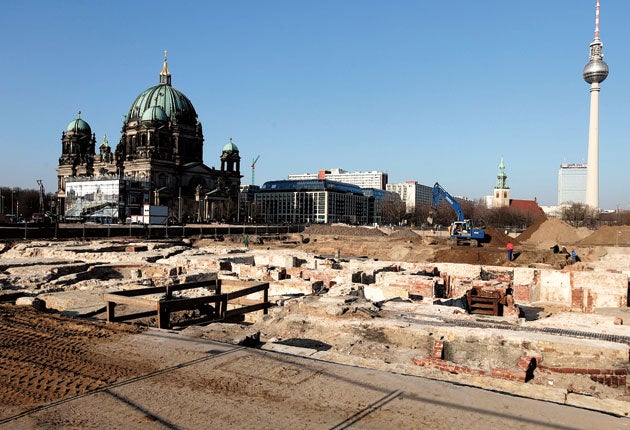Tony Paterson: The green wound that won’t heal
Notebook

When it comes to documentaries about – dare I mention it – the Second World War, German television almost invariably starts off with an aerial film clip showing row upon row of shattered Berlin apartment blocks recently reduced to rubble by allied bombing raids.
The harrowing images have become anenduring symbol of modern Germany’s guilt-ridden “Stunde Null” or “Zero Hour”. Itis the moment when a defeated nation, brought finally and utterly to its knees, had to start all over again.
You might think that “Zero Hour” had long passed. However in downtown Berlin it looks as if only 30 minutes of it have elapsed. The rubble has gone but a vast empty space the size of four football pitches spreads like a grass-covered wound across what, geographically at least, is the city’s heart.
Part of the site was once occupied by Berlin’s 18th century Prussian imperial palace. But by the end of the war the building was little more than a bombed out shell and in 1950, despite protests, it was razed by East Berlin’s communists for being a symbol of hated imperialism.
The communists replaced the Prussian palace with their own glass and concrete “Place of the Republic” which housed East Germany’s rubber-stamp parliament. But despite more opposition, this time from former East Germans, the asbestos-plagued communist palace was also demolished. The last remains of the building were removed less than a year ago, leaving Berlin with its green wound and uncertainty about the city centre’s future.
It had always been convenient to blame allied airforces, the communists or the “capitalist victors” of German reunification for the sorry state of Berlin’s heart. But evidence has now emerged which shows that the wholesale demolition of the capital’s old centre began much earlier.
The driving force behind the radical changes was what by today’s standards would be considered a fanatically anti-conservationist Berlin municipal government which in the 1870s and 1880s remained bent on a programme of “modernisation”. The aim was to equip Berlin for its new role as the capital of all Germany following the country’s first “unification” in 1871.
The destruction of old Berlin is graphically documented in a new exhibition entitled “Berlin’s lost centre”. Sketches, daguerrotypes and early photographs show how the municipal government deliberately ripped out the city’s 17th-century old quarter to make way for new wide thoroughfares with important names like Kaiser Wilhem Strasse. Whole sections of the old town were simply left to rot to make demolition easier.
One of the main proponents of the destruction programme was a councillor called Ernst Bruch. He ordered 103 Berlin city streets to be widened or “ broken through” at a time when transport stood at an average of 595 inhabitants per horse-drawn carriage. The Nazis followed in the 1930s with another demolition programme – mercifully never completed – which was part of a grandiose plan to create Hitler’s Third Reich capital, Germania. The allies and the others did the rest.
So what future for Berlin’s grassed-over heart? Parliament voted back in 2002 to replace the now demolished communist palace with a replica of its former Prussian imperial equivalent. But with costs for the new / old building at 552m euros and record spending deficits inherited from the economic crisis, Angela Merkel’s government has decided to postpone delivery of its share of the funding indefinitely. Like much else in the heart of Berlin, the palace is on hold.
Festive trade in freefall thanks to police firepower
Berlin has always been big on Christmas markets. Sad, down-at-heel versions of their opulent western equivalents were even permitted in former communist East Berlin, although the atheist regime insisted on calling festive angels “Year end figures with wings”.
In today’s painstakingly reconstructed parts of the city, such as Berlin’s Gendarmenmarkt square, the organisers of one very upmarket Christmas market have decided to charge visitors an entry fee to keep the city’s plebs at arms length. The stall-holders may now regret the idea.“Business is catastrophic this year,” said Uwe Speer, who runs a stall selling Glühwein, “Attendance is down by two-thirds,” he maintained.
Uwe blames snow, temperatures of around –8C and the government’s recent warnings about terrorist attacks. Uwe says the police officers brandishing sub-machine guns who keep marching past his stall are the problem. They frighten the tourists.
Homeowners swept up in snowfall crackdown
This being Germany, winter’s early arrival has been accompanied by new laws which allow the authorities to impose draconian fines of up to 10,000 euros on homeowners who fail to adequately sweep snow from the front of their houses.
However the lack of enough snow-clearing firms, which usually do the job for householders, has created a major problem. Many are finding that because they can’t find a firm, they have to do the job themselves.
In some cases Teutonic enthusiasm for obeying the law has caused dire predicaments. One elderly couple asked street wardens policing snow clearance whether they should “cancel their Christmas holiday” to keep up with their snow-clearing duties. They weren’t being ironic.
tpate94811@aol.com

Join our commenting forum
Join thought-provoking conversations, follow other Independent readers and see their replies